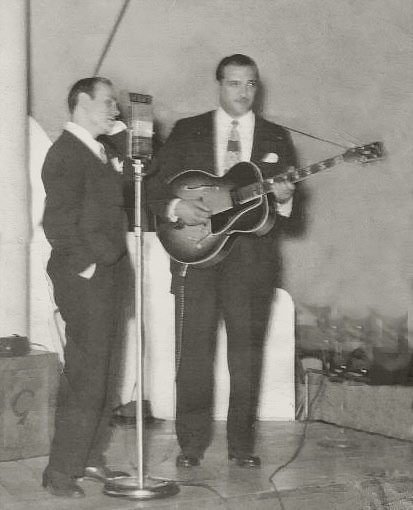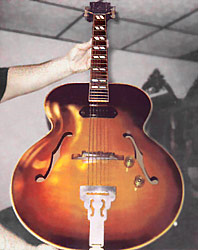The Rock Around the Clock guitar
As recorded by Danny Cedrone
With guitar tab, PowerTab midi file - Download and listen!
By Vince Gordon The gear used on Rock Around the ClockOn Rock Around the Clock Danny Cedrone played a mid to late ‘46 honey-brown, sunburst Gibson ES-300 (serial number 21 G4669) with one P-90 Pickup (First introduced on this guitar model) through an 18 watt, top-of-the-line Gibson BR-1 Amp with a 12" Jensen speaker. The amp featured tone controls which was not usual at the time of production ('46-'49). The ES-300 was also top-of-the-line in Gibson guitars at the time. The body was usually made of laminated maple (new for the ES-300 after WWII) and had a soundpost. The specs for this particular ES-300 are as follows: Two-piece top of solid maple showing moderate flame; two translucent gold barrel knobs; one P-90 pickup; nickel plated tailpiece with f holes; tulip shaped tuners on non screw plates; one-piece mahogany neck; rosewood fingerboard with double parallelogram inlays; the head inlaid with black letter logo and crown device; no cut-out, unbound f-holes. This "Rock Around the Clock guitar" is currently on display at the Rock'n'Roll Hall Of Fame in Cleveland, USA.
The Rock Around the Clock storyDanny Cedrone had previously worked as a session musician with Bill Haley and His Comets when he went into a 3-hour recording session with them on April 12th, 1954. At the end of the session, they began work on "Rock Around the Clock". There were only some 40 minutes left because the producer Milton Gabler was more interested in getting the first song on their list, "Thirteen Women", in the can than "Rock Around the Clock". Probably because he had a piece of the action of "Thirteen Women". That would also explain why "Rock Around the Clock" was released first as the "B" side to "Thirteen Women"!
Walter Carter of Gruhn Guitars in "The P-90 pickup (black plastic with “dog ear” mounting extensions) didn’t appear until after WWII. Gibson stopped all production on electrics during WWII due to metal shortages. When the ES-300 was reintroduced after the war, it was in mid-1946 and had a single P-90 pickup. Only the very first ones had the flat tailpiece with the two f-hole cutouts. The G stamped on the body indicates that the body was made in 1941 and then finished out after the war, so it would have been among the first. By 1947 the ES-300s had a more standard, “trapeze” style tailpiece. Beginning in 1948, the ES-300s had two pickups. So it has to be from mid to late 1946." Later, members of the Comets have almost been standing in line (I know of three!) to take credit for suggesting to Danny Cedrone that he play the lead from "Rock the Joint", which he had recorded with Haley in 1952, on "Rock Around the Clock". This supposedly happened right there at the actual session. While it might be the case that someone suggested the solo to Danny Cedrone, I find it very hard to believe for several reasons. One of them being that Bill Haley and Danny Cedrone had met a couple of days earlier over dinner at the Cedrone's house and went over "Rock Around the Clock" with Bill Haley playing an acoustic and Danny Cedrone playing lead. Right there and then they tried out the solo from "Rock The Joint". Another reason is the very simple one that Cedrone was a very accomplished musician who took pride in his work and knew what he was doing. Why on earth would he need someone in the band to tell him what to play? A session musician? Session musicians are used because the people in charge of the session count on them knowing what to play, better than the regular band musicians. Anyway, we'll never know for sure because Danny Cedrone, tragically, died from a fall less than a month after the recording session. It was more than a year later, when the song was used in the movie "Blackboard Jungle" that it finally hit the number one Billboard spot, one day before Bill Haley's 30th birthday. This time as a re-release with "Rock Around the Clock" on the A side. Danny Cedrone had received $21 dollars pay for a guitar solo which would become one of the most recognizable and famous in rock music history and indispensable to "Rock Around the Clock", the very first Number One Rock and Roll song.
The Guitar Tab for Rock Around the Clock (solo only) By Stu Frederick: To show that in tab, I use two different measure formats, one that divides the measure into 16th notes (4 per beat) and the other in 12 triplet notes (3 per beat). This is represented by the number of dashes in each measure. Download the Rock Around the Clock solo as a PowerTab: A powertab file (.ptb) has midi that lets you listen to the solo (it plays from your soundcard like other midi files) and even change the tempo and key. PowerTab is a free Windows based program that you can download here. The Rock Around the Clock lead is 12 bars long, and it's a standard blues-based | A | A | A | A | D | D | A | A | E | E | A | A | progression. The first four bars have the 'straight' feel; the second four, a 'triplet' feel; and the third, divided between the two. The Rockabilly Jam tracks CD will provide perfect backing if you want to play this solo. NOTE: Any TAB is an INTERPRETATION of the author's work. In my approach to this one, I write what I believe the artist intended. One more thing I'd like to point out: Cedrone's rhythm work on this song is outstanding! Here's the solo... KEY: A / = half bend up SPEED = 180/minute (fast!) ----------------|----------------|----------------|----------------|
7-/\5-7-/\5-|7-/\5-7-/\5-|------------|------------|
7654------------|--------------|------------|------------||
|
|
|
|

